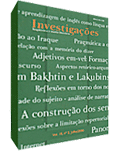O que há num Domínio Pedagógico?
Abstract
Ao longo dos últimos anos, analistas dos gêneros discursivos têm utilizado o termo domínio discursivo em seus trabalhos. Muito freqüentemente, o conceito não é explicitado, parecendo ser assumido como auto-explicativo. Visando, como um objetivo maior, caracterizar melhor o chamado domínio pedagógico, este trabalho discute os critérios que têm sido mais utilizados para sua caracterização.
References
Bakhtin, M.M. 1979. Marxismo e Filosofia da Linguagem. Trad. M. Lahud & F. Oliveira. São Paulo: Hucitec.
______. 1992. Estética da Criação Verbal. Trad. M.E.G.G. Pereira. São Paulo: Martins Fontes.
Bazerman, C. 2005. Gêneros Textuais, Tipificação e Interação. Org. A.
Dionísio & J. Hoffnagel. Trad. J. Hoffnagel. São Paulo: Cortez.
Bernstein, B. 1990. Class, Codes and Control. Vol. 4: The Structuring of
Pedagogic Discourse. London: Routledge.
______. 1996 Pedagogy, symbolic control and identity: theory, research,
critique. London: Taylor & Francis.
Chouliaraki, L. 1999. Regulative practices in a ´progressivist´ classroom: ´good habits as a ´disciplinary technology`. Multilingual Matters & Channel View Publications. Volume 10 (2): 103-108.
Drew, P. & Heritage, J. (eds). 1992. Talk at Work. Interaction in Institutional
Settings. Cambridge: CUP.
Edmondson, W. 1985. Discourse worlds in the classroom and in foreign
language learning. Studies in Second Language Acquisition, 7: 159-168.
Ellis, R. 1990. Instructed Second Language Acquisition. Oxford: Blackwell.
Hall, C., Sarangi, S. & Slembrouck, S. 1999. Special representation and the categorization of the client in social work discourse. Text 14 (4): 539-570.
Hesler, S. & Francis, D. 2001. Is institutional talk a phenomenon? Reflections on ethnomethodology and applied conversational analysis. In A. McHoul & M. Rapley (eds), How to Analyse Talk in Institutional Settings. A casebook of Methods. London: Continuum, pp. 206-217.
Johns, A. M. 1995. Genre and pedagogical purposes. Journal of Second
Language Writing, 4 (2): 181-190.
Lave, J. & Wenger, E. 1991. Situated Learning. Cambridge: CUP.
Marcuschi (em prep). Gêneros Textuais: Constituição e Práticas Sóciodiscursivas. (versão mimeo de 2005)
McHoul, A. 1978. The organization of turns at formal talk in the classroom. Language in Society (7): 183-213.
Maynard, D. 1991. Interaction and asymmetry in clinical discourse. American Journal of Sociology, Vol. 97, No. 2 (Sep., 1991): 448-495.
Scollon, R., Bhatia, V., Li, D., Yung, V. 1999. Blurred Genres and Fuzzy
Identities in Hong Kong Public Discourse: Foundational Ethnographic Issues in the Study of Reading. Applied Linguistics. 20/1:22-43
Waring, H.Z. 2002. Displaying substantive recipiency in seminar discussion. Research on Language and Social Interaction, 35(4): 453-479.
Wenger, E. 1997. Communities of Practice. Learning, Meaning, and Identity. Cambridge: CUP.
Downloads
Published
How to Cite
Issue
Section
License
Copyright (c) 2005 Kazue Saito Monteiro de Barros

This work is licensed under a Creative Commons Attribution 4.0 International License.
Authors who publish with Revista Investigações agree to the following terms:
Authors retain copyright and grant the journal right of first publication with the work simultaneously licensed under the Creative Commons Attribution 4.0 International (CC BY 4.0) license that allows others to share the work with an acknowledgement of the work's authorship and initial publication in this journal.
Authors are able to enter into separate, additional contractual arrangements for the non-exclusive distribution of the journal's published version of the work (e.g., post it to an institutional repository or publish it in a book), with an acknowledgement of its initial publication in this journal.
You are free to:
Share — copy and redistribute the material in any medium or format for any purpose, even commercially.
Adapt — remix, transform, and build upon the material for any purpose, even commercially.
The licensor cannot revoke these freedoms as long as you follow the license terms.
Under the following terms:
Attribution — You must give appropriate credit , provide a link to the license, and indicate if changes were made . You may do so in any reasonable manner, but not in any way that suggests the licensor endorses you or your use.
No additional restrictions — You may not apply legal terms or technological measures that legally restrict others from doing anything the license permits.

